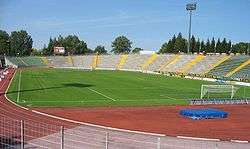Rosenaustadion
 |
| Location |
Augsburg, Germany |
|---|
| Owner |
City Augsburg |
|---|
| Capacity |
official: 28.000 |
|---|
| Construction |
|---|
| Opened |
September 16, 1951 |
|---|
| Renovated |
2007 |
|---|
| Construction cost |
1,1 - 1,8 million DM |
|---|
| Architect |
Erste Pläne: Thomas Wechs, Ausführung: Stadtbaurat Werner |
|---|
| Tenants |
|---|
|
FC Augsburg |
Rosenaustadion is a multi-purpose stadium in Augsburg, Bavaria, Germany. It is the largest stadium in the city.
Until 2009, the stadium was used mostly for football matches by the football club
FC Augsburg. It has an official capacity of 32,354 people. It was built in 1951. In 2009, it was replaced by the Impuls Arena
History
The stadium was built from 1949, using debris from the aerial bombings of the Second World War. The original plans for the stadium however go back to 1926. A temporary narrow gauge railway line run from 1946 from the city centre to the construction site, carrying 185,000 tonnes of debris to be used at the new stadium.
The Rosenaustadion was opened on 16 September 1951 with a Germany versus Austria football match, a B-international, drawing a crowd of 51,000.
From 1951 to 1972 the Rosenau-stadium possessed an outstanding meaning for German sport, particularly in the disciplines of football and athletics, due to its size and modernity. With the opening of Munich's Olympiastadion for the 1972 Summer Olympics, this position was lessened. Despite this, the stadium did host five football matches during these games.

Rosenaustadion
The record attendance of FC Augsburg dates from 1973 with the game against the 1. FC Nuernberg with 42,000 spectators. The highest attendance at a football game was nearly 65,000 spectators on 9 November 1952 with the international match Germany – Switzerland.
The total record is from the year 1958, as 85.000 came to see the athletics team of Germany defeating the Russian team.
The record crowd for the home side FC Augsburg is 45,000, which attended the game in the Regionalliga Süd versus 1. FC Nuremberg on 3 August 1974.
References
FC Augsburg |
|---|
|
| Information | |
|---|
|
| Stadia | |
|---|
|
| Rivalries | |
|---|
|
| Predecessor clubs | |
|---|
|
| Seasons | |
|---|
|
|---|
|
- 1900
- Vélodrome de Vincennes
- 1904
- Francis Field
- 1908
- White City Stadium
- 1912
- Råsunda IP, Stockholm Olympic Stadium (final), Tranebergs Idrottsplats
- 1920
- Jules Ottenstadion, Olympisch Stadion (final), Stade Joseph Marien, Stadion Broodstraat
- 1924
- Stade Bergeyre, Stade de Colombes (final), Stade de Paris, Stade Pershing
- 1928
- Monnikenhuize, Olympic Stadium (final), Sparta Stadion Het Kasteel
- 1936
- Hertha-BSC Field, Mommsenstadion, Olympiastadion (final), Poststadion
- 1948
- Arsenal Stadium, Champion Hill, Craven Cottage, Empire Stadium (medal matches), Fratton Park, Goldstone Ground, Green Pond Road, Griffin Park, Lynn Road, Selhurst Park, White Hart Lane
- 1952
- Helsinki Football Grounds, Kotka, Lahti, Olympic Stadium (final), Tampere, Turku
- 1956
- Melbourne Cricket Ground (final), Olympic Park Stadium
- 1960
- Florence Communal Stadium, Grosseto Communal Stadium, L'Aquila Communal Stadium, Livorno Ardenza Stadium, Naples Saint Paul's Stadium, Pescara Adriatic Stadium, Stadio Flaminio (final)
- 1964
- Komazawa Olympic Park Stadium, Mitsuzawa Football Field, Nagai Stadium, Tokyo National Stadium (final), Nishikyogoku Athletic Stadium, Ōmiya Football Field, Prince Chichibu Memorial Football Field
- 1968
- Estadio Azteca (final), Estadio Cuauhtémoc, Estadio Nou Camp, Jalisco Stadium
- 1972
- Drei Flüsse Stadion, ESV-Stadion, Jahnstadion, Olympiastadion (final), Rosenaustadion, Urban Stadium
- 1976
- Lansdowne Park, Olympic Stadium (final), Sherbrooke Stadium, Varsity Stadium
- 1980
- Dinamo Stadium, Dynamo Central Stadium, Grand Arena, Grand Arena (final), Kirov Stadium, Republican Stadium
- 1984
- Harvard Stadium, Navy–Marine Corps Memorial Stadium, Rose Bowl (final), Stanford Stadium
- 1988
- Busan Stadium, Daegu Stadium, Daejeon Stadium, Dongdaemun Stadium, Olympic Stadium (final)
- 1992
- Estadi de la Nova Creu Alta, Camp Nou (final), Estadio Luís Casanova, La Romareda, Sarrià Stadium
- 1996
- Florida Citrus Bowl, Legion Field, Orange Bowl, RFK Memorial Stadium, Sanford Stadium (both finals)
- 2000
- Stadium Australia, Brisbane Cricket Ground, Bruce Stadium, Hindmarsh Stadium, Melbourne Cricket Ground, Olympic Stadium (men's final), Sydney Football Stadium (women's final)
- 2004
- Kaftanzoglio Stadium, Karaiskakis Stadium (women's final), Olympic Stadium (men's final), Pampeloponnisiako Stadium, Pankritio Stadium, Panthessaliko Stadium
- 2008
- Beijing National Stadium (men's final), Qinhuangdao Olympic Sports Center Stadium, Shanghai Stadium, Shenyang Olympic Sports Center Stadium, Tianjin Olympic Center Stadium, Workers' Stadium (women's final)
- 2012
- City of Coventry Stadium, Hampden Park, Millennium Stadium, St James' Park, Old Trafford, Wembley Stadium (both finals)
- 2016
- Estádio Nacional de Brasília, Arena Fonte Nova, Mineirão, Arena Corinthians, Arena da Amazônia, Estádio Olímpico João Havelange, Maracanã (both finals)
| |
Coordinates: 48°21′19″N 10°52′34″E / 48.35528°N 10.87611°E / 48.35528; 10.87611

